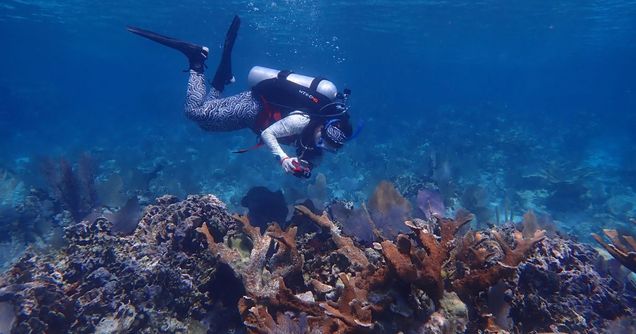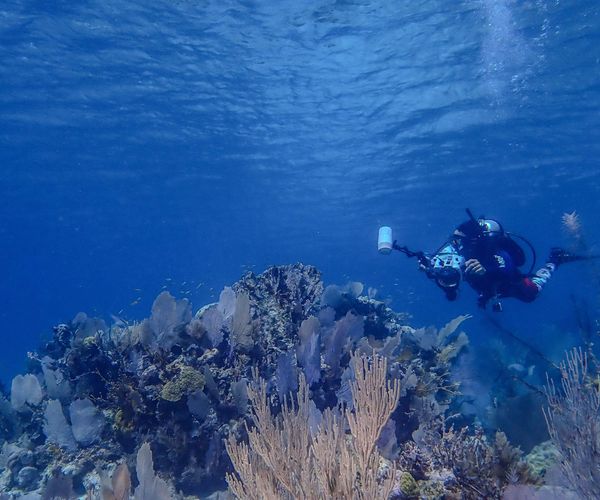Through an NSF-funded project, BU experts protect coastal ecosystems and engage people living on reef-lined coasts.
By Hannah Connell (IGS Communications Assistant, spring 2025)

Flooding, storm surge, and sea-level rise are increasing with climate change, threatening marine ecosystems and the livelihoods of onshore communities. Coastlines provide environmental and cultural benefits to people nearby and sustain key economic activities, like fishing and tourism.
Understanding the connections between human societies and coastal ecosystems is essential to helping both adapt and thrive. Boston University Professor of Biology Les Kaufman, a core faculty member at BU’s Institute for Global Sustainability (IGS), draws on field observations, lab experiments, and data science to understand how aquatic ecosystems change over time and affect the people living nearby.
Kaufman works to build coastal resilience in communities around the world. A major six-year, multi-institutional National Science Foundation (NSF) project, Coastlines and People (CoPe), currently funds his long-term studies in Belize.
Central to the group’s research is the study of coupled human-natural systems, which explores how governance, social, and economic systems are intricately connected to ecosystems. Kaufman’s team is creating ecological forecast models to support management strategies and decision-making. This work is in collaboration with Research Assistant Professor of Biology and IGS affiliated faculty member Ethan Deyle, along with Professor of Earth & Environment and IGS core faculty member Sucharita Gopal.
We spoke with Kaufman to learn about systems ecology, coupled human-natural systems, and community-engaged climate research.
Q&A with Les Kaufman
Can you describe the overarching research goals of the Kaufman-Deyle Lab?
We are a systems ecology lab interested in how ecosystems function. Systems ecology is an attempt to understand the drivers and outcomes of changes over time in whole ecosystems. It differs from many other approaches in that you’re looking at the emergent behavior. ‘Emergent behavior’ is a term that describes the often surprising outcomes of the complex dynamics of natural processes within an ecosystem. More often than not, that behavior cannot be easily predicted just by knowing what the elements are doing. The overall functioning of the ecosystem arises from the way elements within it interact, which is captured by our approach.
What are the main goals of the multi-institutional CoPe project? How are BU researchers contributing their expertise?
The multi-institutional team encompasses Boston University, the University of Miami, the University of Belize, Eastern Carolina University, the University of California Santa Cruz, and Stanford University. This project is led by the University of South Florida. We hope to help people prepare for more of these horrible storms, warming events, and sea-level rise. We also want to understand how people make a living.
Our lab’s contribution to the project is expertise in the biology of mangroves, the biology of coral reefs, and the dynamics of coupled human-natural systems (or the interaction between people and the biophysical system). At BU, we are creating a model for two sites in Belize—Placencia and Caye Caulker. We’re looking at all aspects of fisheries, tourism, real estate, biodiversity, and maintenance. We have been creating models and writing equations to address interactions within tropical ecosystems. For example, what sediment is coming down from the watershed? How is that related to the buildup of the beaches? How is it related to the growth of mangrove forests? That’s part of the model we’ve already done, and we’re moving on now to modeling the fisheries.
How does this research on coral reef recovery benefit the local community in Belize?
The local community depends on the physical protection afforded by reefs and other shallow areas that help to break the waves and reduce wave energy. In the case of Placencia, the peninsula is quickly eroding. We have been working with Fragments of Hope, a community-based organization focused on coral restoration in Belize, for more than ten years now to study the coral reef recovery of a national park, which is a critical tourist resource.
The University of Miami, one of our collaborators, has invented a concrete sculpture designed to break the waves and reduce wave energy. This structure also provides a habitat for living organisms. The idea is to create a hybrid engineered structure that resembles a natural habitat. We’re studying how the coral recovers, we’re studying how the mangrove recovers, and we want to put all that together on these structures to learn if we can actually create something durable that has biodiversity value close to shore.
How do students contribute to the work being done in your lab on CoPe and other projects?
The great thing about this project is that students are front and center. We have graduate students funded by the NSF who are studying coral, ecosystem functioning, and landscape ecology. We accommodate many undergraduate students, and they learn a lot. One group of undergraduates uses machine learning, AI-driven analysis of the coral community to explore long-term changes in coral cover and growth. Another group is working on mangroves and GIS, including students interested in the human dimension.

Your work assesses changes in ecosystem health over the course of decades. What is the significance of long-term ecological research?
Some of nature’s cycles require decades to perceive. Something you do now, thinking only in a one- or five-year timeframe, will have consequences over half a century that you can’t possibly anticipate unless you’ve looked at the previous half-century. To mitigate future climate impacts, we need decades of high-tech, fully sophisticated studies of how ecosystems function, and in particular, how people function within them. Our goal in this lab is to do our part in that intellectual growth.
“To mitigate future climate impacts, we need decades of high-tech, fully sophisticated studies of how ecosystems function, and in particular, how people function within them. Our goal in this lab is to do our part in that intellectual growth.”
What are your hopes for the future of your field?
I certainly hope we still do organism-centered work. That’s really where my heart is. Having a fuller awareness of the elements of a system, how they interact, and how emergent behavior comes about, is basically where we need to go. This is not a side discipline. This is the science of sustainability.
We have a chance to ignite a passion for natural history that provides the backdrop for fully benefiting from modern technology. Having a personal relationship with organisms provides the mental scaffolding on which everything else hangs—understanding animal behavior, understanding physiology, understanding anything. If there is one enduring contribution from the lab, my hope is that our students leave as modern biologists, not only skilled in what they do at the bench or on the computer, but able to give a nature tour anywhere.
Responses have been edited for length and clarity.
